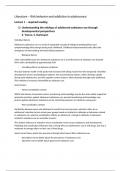Samenvatting
Summary Literature Risk behavior and Addiction in Adolescence
This is a summary of all mandatory articles for the course 'risk behavior and addiction in adolescence'. All of the articles are named and summarized in the right order concerning the order of the course. The summary is written in October of 2023
[Meer zien]




